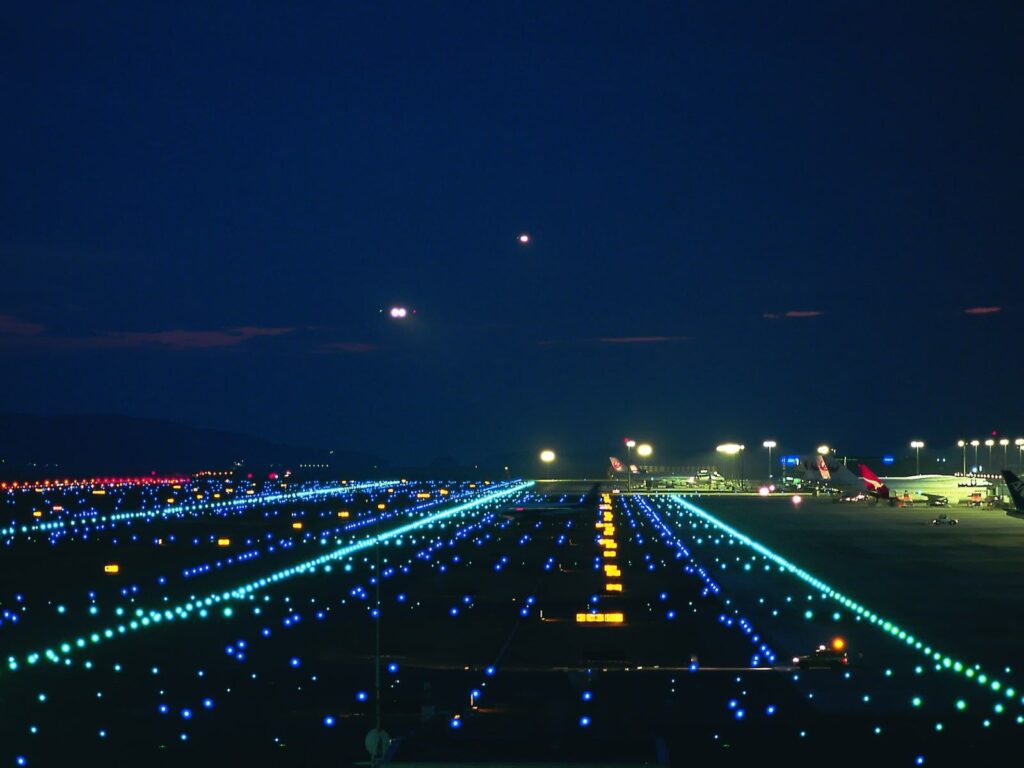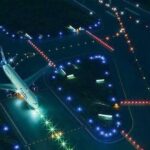
Follow the Greens – Airfield Lighting
10th September 2021 // Follow the Greens Review….
Pre COVID-19, the number of flights taking off and arriving at some of the world’s busiest airports had doubled in the last 20 years. In Europe, the expected traffic growth to 2035 predicts a situation to develop where effectively the skies are full and no further slots are available using the current infrastructure.
Improved processes in the sky and on the ground are paramount if the growth in passenger numbers is to be accommodated safely and economically.
Airports need to improve the utilisation of the taxiway and runway infrastructure whilst assisting the ATM Authorities in better management of aircraft to achieve adherence to allocated slot times and increasing the punctuality of departures and arrivals.
Follow the Greens – Airfield Lighting
Reduce Aircraft Emissions on Taxiways
Reduction in CO2 is a key driver for airports to implement new technologies and Follow the Greens (FtG) is an enabler to reduce aircraft fuel burn between the runway and apron / gate. As an example, aircraft taxiing between the runway and apron uses a not insignificant amount of a fleets annual fuel consumption, which can be improved by reducing taxiing time by leveraging existing technologies to optimise traffic control.
Most surface movement guidance systems in operation at the world’s airports, have pilots following instructions from Air Traffic Control who provide the surveillance, route planning and conflict avoidance task. This works well in good visibility conditions, however, when the visibility conditions degrade, Air Traffic Control operators are less capable in seeing the individual aircraft, and pilots need to take increased care to follow the cleared taxi route, in addition to seeing and avoiding each other.
However improved throughput as well as enhanced safety levels can be achieved in poor visibility conditions with the use of technology and the implementation of an Advanced Surface Movement Guidance Control System (A-SMGCS). A-SMGCS is a system providing routing, guidance, and surveillance for the control of aircraft and vehicles to maintain the declared surface movement rate under all weather conditions within the visibility level at the aerodrome, while maintaining the required level of safety.
SMGCS – Level 4 – Follow the Greens
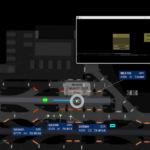 A Follow-the-Green taxiway guidance system is an integral part of an A-SMGCS Level 4 guidance system, where the role of the air traffic controller in supervising the taxiway guidance of aircraft movements between Runway and Parking stand is automated by the use of using a Surface Manager System computer (SMAN). The SMAN equipment is at the heart of the routing and planning of routes, and takes away from the Air Traffic Controller in a fully automated system the determination of:
A Follow-the-Green taxiway guidance system is an integral part of an A-SMGCS Level 4 guidance system, where the role of the air traffic controller in supervising the taxiway guidance of aircraft movements between Runway and Parking stand is automated by the use of using a Surface Manager System computer (SMAN). The SMAN equipment is at the heart of the routing and planning of routes, and takes away from the Air Traffic Controller in a fully automated system the determination of:
- Taxiway Routing and Stop bar switching
- Conflict Resolution
- Runway Protection
- Follow the Green Guidance
- Speed of taxiing Aircraft and ability to meet slot times.
Follow the Green means many things to many people, and the modern interpretation is the dynamic selection of green lights in front of the aircraft (or vehicle), usually because of the controller selecting a start and finish point on a working position in the Control Tower HMI. The A-SMGCS system plans out a dedicated route for the respective aircraft, to avoid conflicts and maximise use of the taxiway network to improve traffic flow. This means that the system has the capability to use similar routes for different aircraft, however each aircraft route is uniquely selected for that aircraft.
To achieve this, taxiway centre line lights are automatically and progressively switched on in segments (or individually) as the aircraft (or vehicle) moves along its assigned route. Pilots and vehicle drivers receive a single instruction to ‘follow-the-greens’ from ATC. If stop bars are implemented to protect no-go areas, they are also automatically commanded.
Reduced Visibility – Follow the Greens
In reduced visibility conditions, throughput capacity can be maintained as the system monitors , and the aircrafts or vehicles position on the airfield as they progress along the selected route, as well as maintaining a safe separation distance between other aircraft and vehicles by switching lights off behind the moving plane.
The number of lights illuminated in front of an aircraft depends on the longitudinal separation to be maintained between aircraft and vehicles in transit. This longitudinal separation is made up of several factors including:
- Distance covered by a following aircraft in the time it takes the pilot, controller and A-SMGCS to react to a sudden occurrence.
- The distance needed for the aircraft to stop at the design taxiing speed which can be around 50km/h.
- The distance to be always maintained between aircraft not taking into account jet blast margin
- The sum of the aircraft length and the margin to be maintained to avoid jet blast effects.
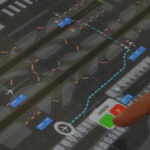 The number of lights switched in front of an aircraft also depends upon the taxiway centre line lighting configuration. Where the taxiways lights are installed in relatively long straight sections, as in the case of fixed block lighting, the length of illuminated lighting is established by longitudinal spacing between the start and end of block stop bars. For safety reasons, one block should be left free between aircraft, although this can limit taxiway capacity.
The number of lights switched in front of an aircraft also depends upon the taxiway centre line lighting configuration. Where the taxiways lights are installed in relatively long straight sections, as in the case of fixed block lighting, the length of illuminated lighting is established by longitudinal spacing between the start and end of block stop bars. For safety reasons, one block should be left free between aircraft, although this can limit taxiway capacity.
As the aircraft progresses along the selected route, the taxiway green lights are extinguished in blocks behind the aircraft to maintain the designed separation between aircraft or mobile objects. Due to the block switching, this generally results in greater separation distances between moving objects and hence this can reduce the throughput in low visibility conditions compared to a variable block system.
Block Switching – Taxiway Centreline Lighting
In a variable block system, the taxiway lighting is installed in shorter sections so that the length of the illuminated block in front of aircraft may vary according to the visual range from two to six switched-on lights, depending on the separation required. As in the fixed block lighting configuration, there are sections of lights that are not illuminated, however because of the increased flexibility of the system the throughput may be increased due to the reduced spacing between moving objects. This type of system is sometimes referred to as a “Floating Bubble” of lights.
The fixed block lighting can be implemented using CCR control or Circuit selectors associated with Taxiway CCR’s whereas the “floating bubble” configuration requires the installation of some form of Individual Lamp Control and Monitoring System (ILCMS). However, whichever system of lighting control is selected, the switching needs to be reliable and relatively quick, so that sections of lighting are switched ahead of a moving aircraft and extinguished behind to maintain separation distance.
The layout of the airfield is an important parameter in the successful implementation of Follow-the-Greens systems along with the operational requirement of the airfield. A Follow-the-Green system does not necessarily need the installation of an ILCMS, however, it does need the layout to be designed to be suitable for Follow-the-Greens guidance control, so that the airfield is divided into controllable blocks.
Successful Follow the Green implementations rely upon the provision of accurate information from airport systems to enable the SMAN to make decisions regarding route planning to avoid conflicts and optimise the taxiway and runway network. Insufficient information and the system is unable to make decisions regarding routing and therefore the high level of A-SMGCS cannot be maintained.
SMAN – A-SMGCS
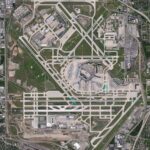
The SMAN will issue instructions via the ALCMS to switch the correct lighting segments in response to the selected guidance route, based upon information received regarding the aircraft position from the surveillance equipment SMR. For the successful implementation of a Follow-the-Greens system, accurate information from the surveillance equipment (SMR) is essential with good robust coverage of <7.5M, equivalent to the spacing between two curve taxiway fittings in Cat III conditions.
To enable the lighting to provide guidance to a pilot of the assigned route, the lighting design needs to be able to clearly display to the pilot the selected route without ambiguity and extinguish lights behind the aircraft so that any following aircraft or vehicles also follow their selected path at the required safe separation.
Typically, the throughput in a variable block system is generally greater than in the fixed block arrangement, due to the flexibility of lamp switching which can be programmed into the ILCMS rather than the block switching using CCR’s and Circuit Selectors.
SMAN A-SMGCS // Advanced Automation Services
- Surveillance Management >> applies mechanisms to eliminate phenomena inherent to the sensor system such as discontinuity, instability and inaccuracy.
- Conflict Management >> continuously scans the traffic situation for critical or unintended occurrences and provides alerts or warnings to the controller.
- Route Management >> proposes individual taxi routes to controllers; provides the management of predefined collective routes.
- Guidance Management >> provides runway protection by dynamic stop bar control; guides individual aircraft along their assigned routes by dynamic taxiway centerline light control (“follow the green”); sequences aircraft at intersections by dynamic stop bar control.
Testing & Results – Follow the Greens
The initial results have been confirmed by SESAR when the TowerPad® technology was used in large scale validation exercises by
- Frankfurt airport (VP-649 in 2013).
- Munich airport (VP-759 in 2015).
- SESAR “Follow the Greens” with a vehicle at Riga airport (VP-761 in 2016 ).
- TowerPad® was already in regular operations at Dubai (DXB). When it encountered its very first day of low visibility operations on January 23th, 2016, it allowed the controllers to achieve a movement rate 62% above the declared capacity.
For more information: Peter.Glover@tm3aiports.com // www.tm3airports.com


